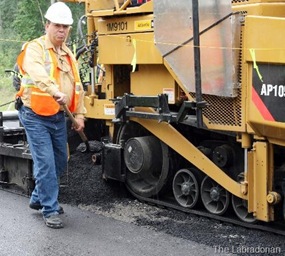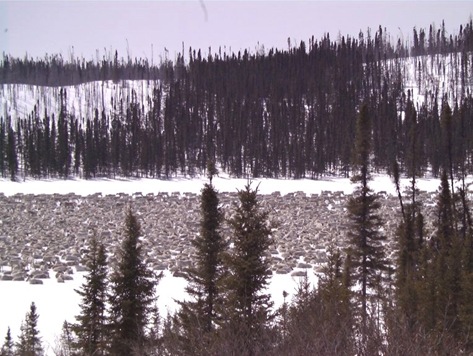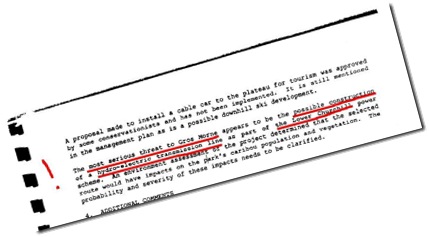After a while, some of this stuff gets repeated so often you could be reading the news with an early undiagnosed case of dementia and not really know for sure that slowly you are losing your grip on reality.
Penashue.
Hickey.
Innu.
Protest.
Caribou.
Is it 2010 or 1987?
The answer - at least for the old Canadian Press clipping below - is 1987. The first clue the story is older is the reference to “Innu Indians” and if you managed to slip by that one, the dead give-away is the mention of protests at a military runway.
Other than that, the rest of the story could be from events of the past six or seven years. A group of Innu, protesting an issue they believe involves their aboriginal rights, decide to kill a few animals from an endangered herd.
A Penashue from Sheshatshiu, in this case Greg, speaks on behalf of the protesters:
''People ask us why we don't sit down and negotiate with government,'' said Greg Penashue, president of the Innu association. ''Well, that's not something I foresee in the near future.
 Meanwhile, there’s a prediction of dire consequences from someone regular readers of these scribbles will recognise as a local favourite:
Meanwhile, there’s a prediction of dire consequences from someone regular readers of these scribbles will recognise as a local favourite:
However, John Hickey, [right, shovelling something else in 2009] president of the Mealy Mountains Conservation Committee, said the illegal hunting could escalate into a full-scale slaughter of the herd.
''What's probably going to happen next year, in my estimation, is Metis hunters and hunters from other communities are going to start operating in there and we're going to have one big massacre in the Mealy Mountains,'' he said.
Now aside from the novelty of seeing the old story recycled in this way, there are a few other lessons to be drawn from all this.
Firstly, the Innu - whether from Quebec or from Sheshatshiu – are past masters at using caribou hunts in sensitive areas as a way of attracting southern media attention for their political cause of the moment.
Second, the caribou herds involved have been used like this for more than 22 years and so far the herds have not been decimated. There is good reason to doubt either the scientists views or, by referring back to that first point, what is actually going on. Innu aren’t stupid people, individually or collectively.
Third, the same cannot be said for the white folks who – each and every year - fall for the same schtick without fail. In that light, John Hickey’s prediction of a “massacre” 22 years ago is laughable. But he is basically no different than the crowd who have played the reflexive, knee-jerk white redneck role in the Annual Media Caribou Frenzy every year since.
What’s especially sad is that some of the biggest parts in the 2010 edition of the annual knee-jerk follies are played by a bunch of politicians who are supposed to be or who should be a heckuva lot smarter than they evidently are. Felix, Danny and Kathy should know better than to get into the racket. They aren’t being played for saps; they have re-written the script for themselves and in the process done absolutely nothing to defuse the situation, strip the protest of its political value or advance the Lower Churchill land claim.
Rather, with their claims that charges might be laid they are showing themselves to be extraordinarily stunned. As lawyers of some experience, Felix and Danny should both know that the aboriginal people of Canada have a constitutionally guaranteed right to hunt, fish and trap subject only to laws about safety and conservation. In this case, showing any conservation issue is going to be highly problematic. The facts speak for themselves.
 In the end, if Danny and Felix try a politically-driven prosecution - a la FPI and yellow-tail flounder, right - they can only lose as a matter of law. They may secure the redneck vote and grumble about the friggin’ courts but that’s going to be of little use once the Innu have a much stronger political position as a result of pure stunnedness.
In the end, if Danny and Felix try a politically-driven prosecution - a la FPI and yellow-tail flounder, right - they can only lose as a matter of law. They may secure the redneck vote and grumble about the friggin’ courts but that’s going to be of little use once the Innu have a much stronger political position as a result of pure stunnedness.
On the other hand, now that Danny and Felix have built up an expectation that charges will be laid against the Innu – presumably knowing there is frig-all chance of a conviction – they are going to look like eunuchs if they decide that a prosecution is a waste of time and don’t lay charges.
They got into this mess, one suspects, for a very well-known habit of one of three - Danny, Felix or Kathy - to shoot from the lip before the brain engages. Henley v. Cable Atlantic is just one of many such examples. The people of the province have seen it countless times since 2003 and - contrary to popular mythology – The Lip has cost taxpayers dearly indeed. This case will likely prove to have a similar high price-tag attached to it.
Either way, the Innu will be stronger as a result of this little escapade. Building up sympathy among the southerners is a time-honoured part of their strategy and it will work now just as it did 22 years ago.
One potentially huge difference in the political response to the Innu outside Newfoundland and Labrador now versus earlier has to do with the level of interest of other governments in the whole affair. If the feds were as attached to the Lower Churchill as they were to low-altitude flight training in the 1980s or if the Lower Churchill project was more than a load of hot air, the federal politicians would be less susceptible to the political pressure that is likely to be applied to them very shortly. There’s no way of knowing for sure – at this point – how they will react.
At the same time, these recent protests and the strong words being tossed highlight the huge cleavages within the Innu communities north and south of the Labrador-Quebec boundary. The white folks in this end of the province might want to consider that in a worst case scenario, there’s no guarantee “our Indians” will side with us against “their Indians.” None of that bodes well for the Lower Churchill.
And if nothing else, all this highlights the sheer idiocy of believing that history started in 2003 and that – in an of themselves – the current lords and ladies ruling this place are inherently smarter than any average bear that went before.
If they were, then they wouldn’t have volunteered so eagerly to play the horse’s arse – yet again - in the pantomime that is Labrador hydro development.
April 22, 1987
Canadian Press
Innu Indians, locked in an escalating battle over native hunting rights and provincial laws, set up tents yesterday on the runway of a military airport.
Five tents were pitched at Canadian Forces Station Goose Bay by members of the Naskapi Montagnais Innu band to protest against the resumption of low-level flights by NATO fighter jets.
The Innu, who believe the flights disrupt the migratory patterns of caribou, were also protesting against the imprisonment of band members arrested on charges of illegally hunting caribou.
The tents, which were not disrupting airport activities, come after a winter of defiance by Innu from the central Labrador community of Sheshatshit.
The Innu, non-status Indians native to Labrador and Eastern Quebec, say they have killed at least 50 caribou from the protected Mealy Mountains' herd on the south coast of Labrador. The Innu consider the area part of their traditional hunting ground.
Six band leaders and Rev. Jim Roach, a Roman Catholic priest, are in jail awaiting a court appearance next week on charges of illegally hunting or illegally possessing caribou meat.
''People ask us why we don't sit down and negotiate with government,'' said Greg Penashue, president of the Innu association. ''Well, that's not something I foresee in the near future.
''How can they guarantee us rights when they throw us in jail virtually every day for practicing our traditional way of life?'' The Innu claim the right to roughly 300,000 square kilometres of land in Newfoundland and Quebec, saying the tribe was hunting caribou as its way of life before Newfoundland existed and has never signed a treaty giving up its rights.
However, John Hickey, president of the Mealy Mountains Conservation Committee, said the illegal hunting could escalate into a full-scale slaughter of the herd.
''What's probably going to happen next year, in my estimation, is Metis hunters and hunters from other communities are going to start operating in there and we're going to have one big massacre in the Mealy Mountains,'' he said.
Other native peoples in Labrador have also claimed traditional rights in the Mealy Mountains. The Innu receive government assistance in the form of subsidized housing, social services and hunting trips.
''If you get right down to it, the Innu went into a section of Labrador which is traditionally used by the Metis people,'' said Joe Goudie, president of the Labrador Metis Association.
''They have impinged on our land without consultation, without anything.''
The Mealy Mountains and the nearby Red Wine Mountains were closed to caribou hunting after the herd dwindled to less than 200 in 1975 from about 2,500 in the 1950s. The Innu are allowed unrestricted access to the George River caribou herd far in the north, whose numbers have mushroomed to more than 700,000.
-srbp-






